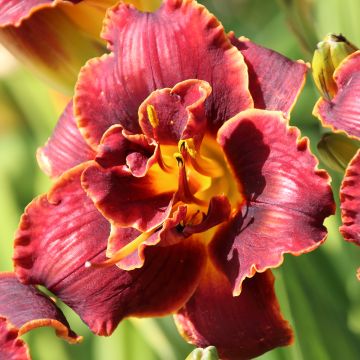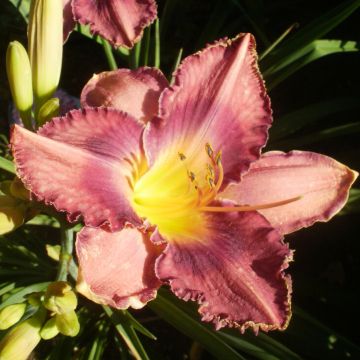

Hemerocallis Amadeus - Daylily


Hemerocallis Amadeus - Daylily
Hemerocallis Amadeus - Daylily
Hemerocallis Amadeus
Daylily
Planted this spring (with plastic bell protection at first, to protect against snails). The plant is doing well, but has not flowered. It will probably flower next year.
Dav, 23/08/2024
Special offer!
Receive a €20 voucher for any order over €90 (excluding delivery costs, credit notes, and plastic-free options)!
1- Add your favorite plants to your cart.
2- Once you have reached €90, confirm your order (you can even choose the delivery date!).
3- As soon as your order is shipped, you will receive an email containing your voucher code, valid for 3 months (90 days).
Your voucher is unique and can only be used once, for any order with a minimum value of €20, excluding delivery costs.
Can be combined with other current offers, non-divisible and non-refundable.
Why not try an alternative variety in stock?
View all →This plant carries a 12 months recovery warranty
More information
We guarantee the quality of our plants for a full growing cycle, and will replace at our expense any plant that fails to recover under normal climatic and planting conditions.
Would this plant suit my garden?
Set up your Plantfit profile →
Description
The Amadeus Daylily is an upright perennial. It constantly renews itself from May to September. The daylily is so called because its flowers only last for one day, but the plant produces multiple stems, each carrying at least 12 flowers. The stems are tall, upright, or arching. The large round flowers of Amadeus are single and measure from 7 to 15 cm (3 to 6in) in diameter. They are composed of thick wavy-edged tepals. They are a striking scarlet red with golden reflections and a yellow throat. The tepals have a central yellow vein. The eye-catching reblooming flower rises above the foliage.
The foliage has numerous semi-evergreen, green leaves. They appear in early spring and last until winter. They are arching and ribbon-like and form a clump. At maturity, the Amadeus Daylily reaches a height of 60 cm (24in) and a spread of 1 m (3ft). It is very hardy and originates from China, Korea, and Japan. It naturally grows in forest edges and meadows, as well as mountainous and marshy areas.
This ornamental plant forms a lovely ground cover due to its dense vegetation. It also works well in perennial borders and alongside shrubs, such as along a wall. It pairs nicely with tulips and daffodils. You can also plant it in flower beds and mixed borders and it can be grown in large pots. It is popular in American gardens. In winter, it enters a period of dormancy.
Report an error about the product description
Flowering
Foliage
Plant habit
Botanical data
Hemerocallis
Amadeus
Hemerocallidaceae
Daylily
Cultivar or hybrid
Other Hemerocallis - Daylilies
View all →Planting and care
Daylilies thrive in sunny locations. Avoid dry or too shady conditions, as they will reduce flowering. Plant them in fertile, moist but well-drained soil. Water them well once or twice a week until the flower buds appear and apply liquid fertiliser every two to three weeks. Once the buds have appeared, the soil can become slightly dry between waterings. It is easy to grow, mulch it in November or March. Daylilies can be susceptible to rust and collar rot in high humidity conditions, combined with temperatures over 30°C (86°F). During periods of frequent freezing and thawing, bacterial rot of stems and leaves can occur. Slugs and snails attack the young shoots.
Planting period
Intended location
Care
-
, onOrder confirmed
Reply from on Promesse de fleurs
Haven't found what you were looking for?
Hardiness is the lowest winter temperature a plant can endure without suffering serious damage or even dying. However, hardiness is affected by location (a sheltered area, such as a patio), protection (winter cover) and soil type (hardiness is improved by well-drained soil).

Photo Sharing Terms & Conditions
In order to encourage gardeners to interact and share their experiences, Promesse de fleurs offers various media enabling content to be uploaded onto its Site - in particular via the ‘Photo sharing’ module.
The User agrees to refrain from:
- Posting any content that is illegal, prejudicial, insulting, racist, inciteful to hatred, revisionist, contrary to public decency, that infringes on privacy or on the privacy rights of third parties, in particular the publicity rights of persons and goods, intellectual property rights, or the right to privacy.
- Submitting content on behalf of a third party;
- Impersonate the identity of a third party and/or publish any personal information about a third party;
In general, the User undertakes to refrain from any unethical behaviour.
All Content (in particular text, comments, files, images, photos, videos, creative works, etc.), which may be subject to property or intellectual property rights, image or other private rights, shall remain the property of the User, subject to the limited rights granted by the terms of the licence granted by Promesse de fleurs as stated below. Users are at liberty to publish or not to publish such Content on the Site, notably via the ‘Photo Sharing’ facility, and accept that this Content shall be made public and freely accessible, notably on the Internet.
Users further acknowledge, undertake to have ,and guarantee that they hold all necessary rights and permissions to publish such material on the Site, in particular with regard to the legislation in force pertaining to any privacy, property, intellectual property, image, or contractual rights, or rights of any other nature. By publishing such Content on the Site, Users acknowledge accepting full liability as publishers of the Content within the meaning of the law, and grant Promesse de fleurs, free of charge, an inclusive, worldwide licence for the said Content for the entire duration of its publication, including all reproduction, representation, up/downloading, displaying, performing, transmission, and storage rights.
Users also grant permission for their name to be linked to the Content and accept that this link may not always be made available.
By engaging in posting material, Users consent to their Content becoming automatically accessible on the Internet, in particular on other sites and/or blogs and/or web pages of the Promesse de fleurs site, including in particular social pages and the Promesse de fleurs catalogue.
Users may secure the removal of entrusted content free of charge by issuing a simple request via our contact form.
The flowering period indicated on our website applies to countries and regions located in USDA zone 8 (France, the United Kingdom, Ireland, the Netherlands, etc.)
It will vary according to where you live:
- In zones 9 to 10 (Italy, Spain, Greece, etc.), flowering will occur about 2 to 4 weeks earlier.
- In zones 6 to 7 (Germany, Poland, Slovenia, and lower mountainous regions), flowering will be delayed by 2 to 3 weeks.
- In zone 5 (Central Europe, Scandinavia), blooming will be delayed by 3 to 5 weeks.
In temperate climates, pruning of spring-flowering shrubs (forsythia, spireas, etc.) should be done just after flowering.
Pruning of summer-flowering shrubs (Indian Lilac, Perovskia, etc.) can be done in winter or spring.
In cold regions as well as with frost-sensitive plants, avoid pruning too early when severe frosts may still occur.
The planting period indicated on our website applies to countries and regions located in USDA zone 8 (France, United Kingdom, Ireland, Netherlands).
It will vary according to where you live:
- In Mediterranean zones (Marseille, Madrid, Milan, etc.), autumn and winter are the best planting periods.
- In continental zones (Strasbourg, Munich, Vienna, etc.), delay planting by 2 to 3 weeks in spring and bring it forward by 2 to 4 weeks in autumn.
- In mountainous regions (the Alps, Pyrenees, Carpathians, etc.), it is best to plant in late spring (May-June) or late summer (August-September).
The harvesting period indicated on our website applies to countries and regions in USDA zone 8 (France, England, Ireland, the Netherlands).
In colder areas (Scandinavia, Poland, Austria...) fruit and vegetable harvests are likely to be delayed by 3-4 weeks.
In warmer areas (Italy, Spain, Greece, etc.), harvesting will probably take place earlier, depending on weather conditions.
The sowing periods indicated on our website apply to countries and regions within USDA Zone 8 (France, UK, Ireland, Netherlands).
In colder areas (Scandinavia, Poland, Austria...), delay any outdoor sowing by 3-4 weeks, or sow under glass.
In warmer climes (Italy, Spain, Greece, etc.), bring outdoor sowing forward by a few weeks.


















































